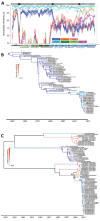Multirecombinant Enterovirus A71 Subgenogroup C1 Isolates Associated with Neurologic Disease, France, 2016-2017
- PMID: 31107209
- PMCID: PMC6537711
- DOI: 10.3201/eid2506.181460
Multirecombinant Enterovirus A71 Subgenogroup C1 Isolates Associated with Neurologic Disease, France, 2016-2017
Abstract
In 2016, an upsurge of neurologic disease associated with infection with multirecombinant enterovirus A71 subgenogroup C1 lineage viruses was reported in France. These viruses emerged in the 2000s; 1 recombinant is widespread. This virus lineage has the potential to be associated with a long-term risk for severe disease among children.
Keywords: 3Dpol; 5′ UTR; C1 subgenogroup; C1v2015 lineage; EV-A71; France; children; coxsackievirus; enterovirus; enterovirus infection; epidemiologic monitoring; genetic recombination; genomic region P1; most recent common ancestor; neurologic disease; neurologic manifestations; viruses; whole-genome sequencing.
Figures


References
-
- Bessaud M, Razafindratsimandresy R, Nougairède A, Joffret ML, Deshpande JM, Dubot-Pérès A, et al. Molecular comparison and evolutionary analyses of VP1 nucleotide sequences of new African human enterovirus 71 isolates reveal a wide genetic diversity. PLoS One. 2014;9:e90624. 10.1371/journal.pone.0090624 - DOI - PMC - PubMed
Publication types
LinkOut - more resources
Full Text Sources

